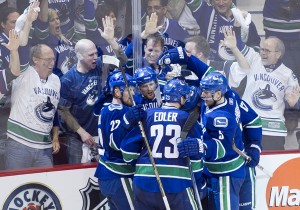The Vancouver Canucks find themselves at the top of the Northwest Division standings as they take on the Minnesota Wild Thursday. It’s familiar air for Vancouver as they have dominated the division and are again the front runner to win it. The way they’ve reached first place this year is a bit different however.
Instead of being a high scoring, high-flying offense that they have relied on the past few years, they are relying on great goal-tending and timely scoring.
Tthese Canucks don’t look too much like the 2010-2011 version of the Canucks that went to the Stanley Cup playoffs. They do however, feel and look familiar.
These Vancouver Canucks resemble the 2006-2007 version of the squad.

The 2006-2007 team won with great goal-tending, good defense and timely scoring. The summer of 2006 saw Vancouver complete a huge trade that brought Roberto Luongo into the fold. The Canucks were desperate for consistent goal-tending as Dan Cloutier and Alex Auld had not been cutting it.
Vancouver got their goalie and nudged Minnesota that year in the Northwest, winning by a single point, and advanced to the second round of the Stanley Cup Playoffs. They were ousted in five games by the eventual champions – The Anaheim Ducks.
The current version of the Canucks resembles that 2006-2007 team, which might be of some concern. Currently the Canucks are averaging 2.44 goals per game and allowing an impressive 2.22 per game. The 2006-2007 team averaged 2.65 goals per game while allowing 2.40. Those numbers are in the same ball park.
The power play has been an issue for Vancouver this year, limping along at a 15.6 percentage. The 2006-2007 team was a tick better at 17.2. That power play let them down against the Ducks in the playoffs as they could not take advantage of the advantage of a number of power plays and were ultimately worn down by Anaheim.
If the current Canucks squad wants to get further than the 2007 team they will need to pick up the scoring, and power play, numbers. The good news is that Ryan Kesler is skating with the team and will give them a big boost when he returns. Kesler is one of the most vital players on the team and his return will help settle the lines and should provide for more scoring.
Kesler may be the thing that separates the 2013 and the 2007 Canucks. In 2007 Kesler was not the player he is now. He played hard, killed penalties, but was younger and had not found his offensive game yet. He only scored six goals and 16 points that year, less than Jan Bulis. When he returns the Canucks will hopefully be getting the Kesler of the past few years.
Vancouver has been getting timely scoring this year and Roberto Luongo may be off to his best start ever with the Canucks. The team has picked up points in each of his starts and has some people questioning whether or not he should still be on the trading block.
The timely scoring has been big as well. The epitome of that came against Edmonton on Monday night as Chris Tanev picked up his first career goal late in overtime to win the game. You can’t time it better than that.
In the end, this year’s Canucks squad should be better than the one in 2006-2007. Their slow start may have nothing more to do with missing Kesler and David Booth, both of whom will help score more goals. But for now, they are going back to the past and winning with a nostalgic whiff of 2007.